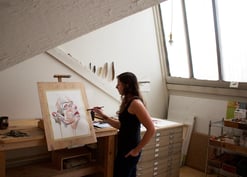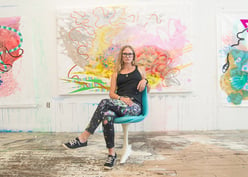Anne Ierardi’s artistic journey tells a story of balance between chasing opportunity, embracing mentorship, and connecting with others while staying true to her creative conviction.
Now based in Yarmouth Port, MA, she draws inspiration from her surroundings, fusing new ideas with personal history. She credits inspirational words from mentors and meaningful connections with others through her art as a driving force behind her work. Today, Anne brings music, movement, and energy to the canvas, prioritizing habits that help her stay in touch with her goals and remain open to new sources of inspiration.
Tell us about your work. What themes or messages do you hope to convey through your art?
I ground my work in expression through color, form, and rhythm. Throughout the creative process, I continually consider how to stay true to my creative vision while also connecting with the world.
During college, the influence of German Expressionism and Post Impressionism deepened as I encountered the work of Kandinsky, Kirchner, Gauguin, Van Gogh, and Chagall. Their use of color and movement was inspiring, and each of their attempts to make sense of suffering and understand the world shaped my artistic direction. Alongside formal art studies, I began a lifelong exploration of psychology, philosophy of art, and theology.
My art and my life have been guided by a desire to extract meaning from the world around me. The liberation movements of the sixties and seventies broadened my perspectives, while artists such as Frida Kahlo, Corita Kent, Kathe Kollwitz, Georgia O’Keeffe, and later Agnes Martin grounded and inspired me.
How can art tell a story and give voice to the voiceless? How can I bring more joy, more peace, more understanding to the world? These remain at the heart of my work.
Tell us about your process.
My process begins with music. In the studio, I move and sing as I work, using an antique wooden ironing board to hold my paints, brushes, and palette. My studio sits on the top floor of my 1820s home, where small crank-out windows evoke the charm of French studios.
These rituals are intended to infuse my work with life. I paint quickly, with intense concentration, emotion, and passion. Once, my professor, Sal Del Deo, a master painter in Provincetown, remarked, “That fish you are painting has so much feeling in the eyes… it reminds me why I can only bear to cook lobster once a year.”
Tell us about your journey to becoming a professional artist. Was there a defining moment or a moment of clarity when you knew this was your path?
In the eighties, I studied to become a minister and a therapist. These disciplines often overlapped with my passion for art. At Harvard Divinity School, one of my favorite courses integrated art with history and theology.
My first counseling position led me south of Boston to Cape Cod, where the environment inspired my second wave of painting and ultimately transformed my life. I studied for many summers with abstract expressionist artists in Truro and Provincetown, many of whom learned from Hans Hoffman. It was here, in the salty air with paint-stained hands, that I started to feel like a “real artist,” and I knew I had found my people.
A former teacher reinforced this direction. I visited her nursing home to decorate her room with paintings for her 100th birthday, and she said something that stuck with me. She said, “The ministry is a noble profession, but don’t neglect your art.” I took her advice and continued pursuing art, exhibiting throughout Cape Cod, and completing a year-long course with the Art Foundation, where I developed a marketing plan and learned how to present my work.
My project, “Walking with Grief,” affirmed art as my true calling, as I realized how painting could intertwine with healing. The project stemmed from a poem written by a friend after the sudden loss of her daughter. It culminated as a series of 21 paintings exhibited in churches, schools, and galleries, and eventually, a published book. The project was a powerful demonstration of the power of art to heal and communicate.
What is your advice for combating creative blocks? Are there any specific strategies you use to reignite your creativity?
Most creative blocks signal a need for transition or shift in energy. In these moments, I often ask myself, “Where am I going? What is missing in my life now?"
I ran Artist’s Way groups for ten years based on the work of Julia Cameron. The practice involves free writing every morning and an artist date every week. Participants are able to let their creativity flow freely and center their practice. One woman went on to have her first art showing, another woman opened a gallery, a group of therapists took time to focus on their own creative outlets, and one couple left the Cape to start an Alpaca farm! These stories demonstrate the importance of taking time to reconnect with creative goals. 
As an artist, how do you measure success? Can you recall a specific event or milestone in your career that made you feel successful?
I try not to “measure” my success as an artist because it can lead to negativity or feelings of inadequacy. It can also result in depending on the world to determine what constitutes “success”.
I feel fulfilled when people respond to my art, especially when my art ignites brighter, deeper, and more expansive emotions. I also enjoy feedback from other artists. Sal Del Deo shook my hand 30 years ago and said, “Well done. Now is the time to show your work at the Provincetown Art Museum,” and so I did. Soon, I sold a painting of boats at the member’s show. While these encouragements keep me going, I believe connecting with others through my art is what truly matters.
What advice do you have for artists who are beginning to build their careers? Have you adopted any habits or strategies that you feel have created more opportunities or visibility for your work?
Connect to communities of artists. Take workshops to keep engaged. Develop business strategies, such as a marketing plan and graphic design skills for promotional materials.
Create a personal goal list. Identify two or three top priority goals to help direct your vision. While these overarching goals are not a “to-do” list, it can be helpful to identify the daily or weekly details that support your vision.
Pursue actions that enrich your mind, body, and spirit. For me, music, jazz dance, personal reflection, retreats, reading, and travel have balanced and supported my painting.
What sparked your interest in partnering with TurningArt?
I would love to share my art more widely, especially in public spaces and workplaces. I believe that art can inspire, educate, and spread joy, and I see bare, sterile spaces as lost potential. What we see and feel on a daily basis is incredibly important.
What is most meaningful to you about being an artist? What drives you to continue creating and pursuing art?
Art keeps me keen to discovery and expression. During the pandemic, I created a series of abstract “Pandemic Paintings” in acrylics, exploring rhythm, flow, and color. One work, Pride, inspired additional pieces shown during Gay Pride Month. Allowing colors to move freely across the canvas opened a new dimension in my work and reaffirmed the joy of continual exploration.

To see more featured TurningArtists, return to our blog. To get Anne Ierardi's art in your space, set up a free consultation with an Art Advisor here!




_VSCO.jpg?width=332&height=177&name=TMoss_Continuum%20Sliver%20copy%20(1)_VSCO.jpg)

